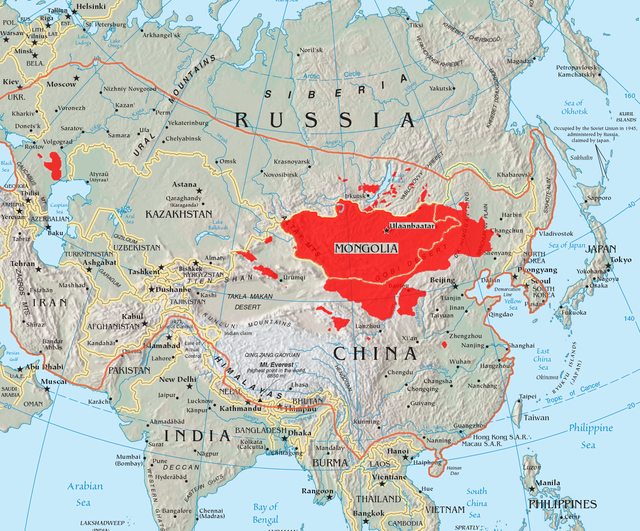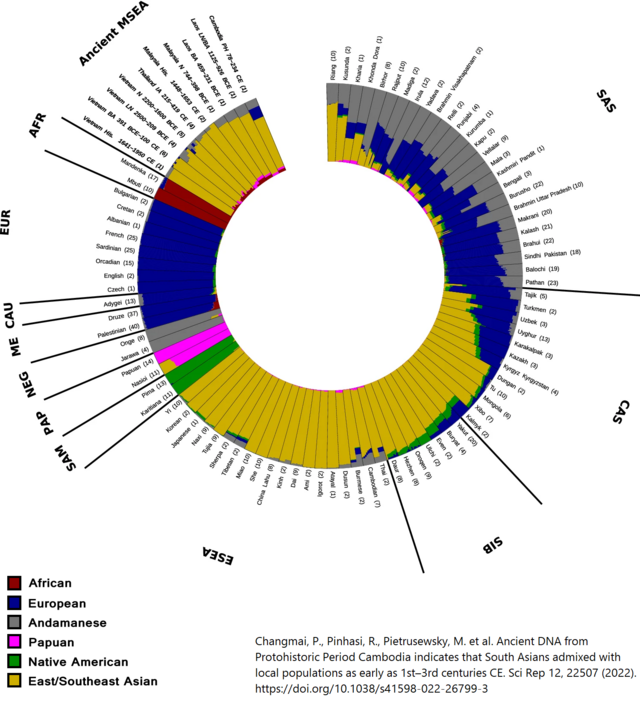The Mongolic peoples are a collection of East Asian-originated ethnic groups in East, North, South Asia and Eastern Europe, who speak Mongolic languages. Their ancestors are referred to as Proto-Mongols. The largest contemporary Mongolic ethnic group is the Mongols.[1] Mongolic-speaking people, although distributed in a wide geographical area, show a high genetic affinity to each other,[2] and display continuity with ancient Northeast Asians.[3]


List of ethnic groups
Contemporary ethnic groups
In addition, Mongolized Soyots live in Buryatia. Their population is 3600 people. Soyots are one of the indigenous minority peoples of Russia. They are descendants of Turkified Samoyeds. At the same time, a number of orientalists (Zhukovskaia,[4] Nanzatov,[5] Baldaev[6] and others) consider modern Soyots as a sub-ethnos within the Buryat people: "... here the ethnic composition of the population was formed, which remains relatively stable to this day - Bulagats, Khongodors, Soyots, who (some earlier, others later) became subethnic groups of the Buryats."[4]
Ethnic groups of Mongolian origin
A large Mongolian component took [citation needed] in the ethnic formation of the Hazaras.[7] The high frequency[citation needed] of haplogroup C2-M217 is consistent[citation needed] with the purported Mongolian origin of many of the Hazaras.[8] Modern Hazaras speak Hazaragi, one of the dialects of the Dari/Persian language.
The Mughals, descendants of the Barlas[citation needed] and other Mongol tribes[citation needed], currently speak Indo-Aryan languages of their respective regions, including Urdu[9] and Punjabi. Although they acknowledge their Mongolic roots, their ethnic identity has shifted to their local South Asian ethnic group.
Historical ethnic groups
General characteristics
Languages
Languages of the Mongolic peoples belong to the Mongolic language family.[10] The Mongolic languages are a language family spoken in Eastern Europe (Kalmykia), Central Asia, North Asia and East Asia. The best-known member of this language family, Mongolian, is the primary language of most of the residents of Mongolia and the Mongol residents of Inner Mongolia and Buryatia, with an estimated 5.7+ million speakers.[11]
The Mongolic ethnicities possibly related to the Turkic and Tungusic peoples,[12] whose languages together would include in the hypothetical Altaic language family.[13]
Religions
The Mongolic peoples are predominantly followers of Tibetan Buddhism. In 1576 the Gelug Tibetan school which was founded by the half-Mongol Je Tsongkhapa became the state religion of Mongolia. Some groups such as Dongxiangs and Bonan people adopted Sunni Islam, as did Moghols in Afghanistan and Mughals in India. Among a part of the population, the ethnic religion, namely Tengrism (Mongolian shamanism) is preserved. A small number of Christians emerged under the influence of the Russian Church and Western missionaries.[14]
Mongolian shamanism, more broadly called the Mongolian folk religion, or occasionally Tengerism[according to whom?], as refers to the animistic and shamanic indigenous religion that has been practiced in Mongolia and its surrounding areas (including Buryatia and Inner Mongolia), as well as among Daur and other peoples, at least since the age of recorded history. In the earliest known stages, it was intricately tied to all other aspects of social life and to the tribal organization of Mongolian society. Along the way, it has become influenced by and mingled with Buddhism.[15] Tengrism was transformed into a monotheistic religion only at the imperial level within aristocratic circles.[16]
Culture
The Culture of Mongolia has been heavily influenced by the Mongol nomadic way of life and shows similarities to other East Asian and Central Asian cultures. The various Mongolic ethnic groups share a highly similar culture and traditions, but have specific differences in clothing styles and cuisine. Although Mongolian traditional clothing (deel) has changed little since the days of the empire, there have been some changes in styles which distinguish modern Mongolian dress from historic costume. Each tribe or clan has its own deel design distinguished by cut, color, and trimming. Mongolian cuisine is primarily based on meat and dairy, with some regional variations. The most important public festivals are the Naadam. A Naadam involves horse racing, wrestling, and archery competitions. For families, the most important festival is Tsagaan Sar (Lunar New Year), which is roughly equivalent to the Chinese New Year and usually falls into January or February. Mongolia has a very old musical tradition. Key traditional elements are throat-singing, the Morin Khuur (horse head fiddle) and other string instruments, and several types of songs. Mongolian melodies are typically characterized by pentatonic harmonies and long end notes.
Origin
The ethnogenesis of Mongolic peoples is largely linked with the expansion of Ancient Northeast Asians. They subsequently came into contact with other groups, notably Sinitic peoples to their South and Western Steppe Herders to their far West. The Mongolians pastoralist lifestyle, may in part be derived from the Western Steppe Herders, but without much geneflow between these two groups, suggesting cultural transmission.[17][18]
Genetics
Mongols and other Mongolic-speaking groups, show high genetic affinity to each other, followed by genetic proximity to Central and East/Southeast Asian peoples. The analysis of 175 Mongolic samples, representing 6 ethnic groups, incorporating results of the 1000 Genomes Project panel, revealed genetic homogeneity between different Mongolic groups, and that Northeast, East, and Southeast Asian populations are closer to each other than to other Eurasian populations.[2]
Maternal lineages
Mongolic peoples maternal lineages are primarily shared with East Asians (54%) and Southeast Asians (28%), while around 14% are shared with Europeans and other West Eurasian populations. The remaining 4% are distributed throughout Eurasia and not associated with a specific group.[19]
A study based on mtDNA noted that ancient populations in Mongolia had a mixed West and East Eurasian origin, while modern Mongolians are characterized by substantially less West Eurasian maternal ancestry. It is suggested that many West Eurasian mtDNA haplogroups in modern Mongolians are believed to have arrived around 2,500-5,000 years ago, or the Mongolian Bronze Age. A smaller number arrived in the early Iron Age.[20] Research by Rogers, et al. provides evidence that some West Eurasian maternal lineages had made it to Mongolia east of the Altai mountains prior to the Bronze Age.[21][22] During the medieval period, a continuous increase in East Asian mitochondrial lineages was detected, which these authors attribute to Genghis Khan's Pax Mongolica.[23]
Paternal lineages
An analysis of the paternal genetic diversity of Mongolians (n=95 from Ulaangom, n=100 from Dalandzadgad, n=97 from Ulaanbaatar, n=84 from Undurkhaan, n=117 from Choibalsan) performed by Toshimichi Yamamoto et alii at the Department of Legal Medicine and Bioethics, Graduate School of Medicine, Nagoya University, Japan revealed a mean frequency of 59.0% Haplogroup C-M217 (49.5% Ulaanbaatar, 57.1% Undurkhaan, 59.0% Choibalsan, 61.0% Dalandzadgad, 68.4% Ulaangom), 13.9% Haplogroup O-M175 (4.2% Ulaangom, 11.0% Dalandzadgad, 13.1% Undurkhaan, 15.4% Choibalsan, 25.8% Ulaanbaatar), 11.3% Haplogroup N-M231 (8.2% Ulaanbaatar, 8.4% Ulaangom, 10.3% Choibalsan, 14.0% Dalandzadgad, 15.5% Undurkhaan), 6.2% Haplogroup R (3.1% Ulaanbaatar, 3.4% Choibalsan, 3.6% Undurkhaan, 7.0% Dalandzadgad, 13.7% Ulaangom), 3.5% Haplogroup D-M174 (1.1% Ulaangom, 3.4% Choibalsan, 4.0% Dalandzadgad, 4.1% Ulaanbaatar, 4.8% Undurkhaan), and 2.8% Haplogroup Q1b (2.0% Dalandzadgad, 2.4% Undurkhaan, 3.1% Ulaanbaatar, 3.2% Ulaangom, 3.4% Choibalsan).[24] The authors noted that "at least 4 major male ancestors with Y-hg-C3 have affected the gene pool of Mongolian males at the different periods," producing star-like clusters of Y-STR haplotypes.[24] Most numerous on average are the members of C3*: 11.6% Ulaangom, 14.4% Ulaanbaatar, 28.6% Undurkhaan, 29.9% Choibalsan, 48.0% Dalandzadgad. Second most numerous on average are the members of Haplogroup C3c: 2.0% Dalandzadgad, 16.7% Undurkhaan, 17.1% Choibalsan, 23.7% Ulaanbaatar, 53.7% Ulaangom. Third most numerous on average are the members of Haplogroup C3d i.e. C-M407: 3.2% Ulaangom, 8.0% Dalandzadgad, 8.5% Choibalsan, 10.7% Undurkhaan, 11.3% Ulaanbaatar.
A study based on ancient DNA and Y-DNA found that ancient populations in the region of modern-day Mongolia had a mixed West and East Eurasian origin during the Xiongnu period. Male-mediated Western Steppe Herders ancestry increased by the establishment of Türkic and Uyghur rule in Mongolia, which was accompanied by an increase in the West Eurasian haplogroups R and J.[25] There was a male-mediated rise in East Asian ancestry in the late medieval Mongolian period, paralleling the increase of haplogroup C2b.[26]
Autosomal DNA

Genetic studies on Mongolic populations found them to be "well-fitted by a three-way admixture" of Ancient Northeast Asian-like (ANA) ancestry, with variable amounts of Yellow River Farmer-like, and Western Steppe Herders ancestries. Mongols of Inner Mongolia were found to display genetic continuity with "Late Medieval Mongol" samples, and can be modeled as 46% Ancient Northeast Asian, 44% Yellow River Farmer, and 10% West Eurasian (Andronovo-like).[28] Mongol Empire period samples carried between 55–64% Ancient Northeast Asian ancestry, 21–27% Yellow River Farmer-like sources, and 15–18% Western Steppe Herder (Sarmatian or Alan-like) sources.[29]
One autosomal study on Oirat-speaking Kalmyks living in Kalmykia, Eastern Europe, found them to be derived from a Western Mongolian source population. Despite their long-distance migration, Kalmyks still display a predominant East Asian genetic profile. Kalmyks derive around 80% East Asian ancestry and 20% Western Eurasian ancestry.[30]
Two autosomal genetic studies on Inner Mongolians found that they are best modeled as a mixture of Ancient Northeast Asian-like (ANA) and 10% to 25% East Asian Yellow River Farmer ancestry sources (increasing among Khorchins to around 62%), with only minor Western Eurasian genetic contributions (5.6–11.6%).[3][18][lower-alpha 2]

Mongolic peoples display genetic continuity to the Devil’s Gate Cave specimen (7,000 BCE) and the Amur13K specimen (13,000 BCE). The Neolithic Northeast Asian ancestry, is shared with other "putative Altaic-speaking peoples" specifically Turkic, and Tungusic-speaking peoples, together with shared "IBD fragments" in haplotype variation, supporting a Northeast Asian origin of these three groups. Turkic and Western Mongolic populations display the relatively highest amounts of West Eurasian admixture, inline with historical contacts between Ancient Northeast Asians and West Eurasian populations of the Eurasian Steppes, and evidence from linguistic borrowings. In comparison, Eastern, Central and Southern Mongolic peoples as well as Tungusic peoples had considerable less West Eurasian ancestry but higher Yellow River farmers ancestry. Sinitic peoples largely lacked any West Eurasian-derived ancestry and displayed primarily affinity with historical Yellow River farmers.[33][34]
Notes
- Some Mongolic ethnic groups are variously described as subgroups of Mongols or as separate ethnic groups; for example, the Buryats and the Kalmyks are recognized as distinct ethnolinguistic groups in Russia (see 2010 Census and other).
- "The gene flow from Western Eurasian was preliminarily detected in Mongol population of TreeMix-based phylogenetic tree; the ancestral source was finally identified in qpAdm, ranging from 5.6 to 11.6% in those Mongolian subgroups; ALDER and GLOBETROTTER supported that the west-east admixture event was recently estimated in the period ranging from Tang Dynasty to Yuan Dynasty. ... We further performed haplotype-based GLOBETROTTER to obtain a high-resolution characterization of the admixture landscaped of three Mongolian subgroups. All targets showed robust signals of west-east admixture (Supplementary Table S11)."[31]
References
Wikiwand in your browser!
Seamless Wikipedia browsing. On steroids.
Every time you click a link to Wikipedia, Wiktionary or Wikiquote in your browser's search results, it will show the modern Wikiwand interface.
Wikiwand extension is a five stars, simple, with minimum permission required to keep your browsing private, safe and transparent.
